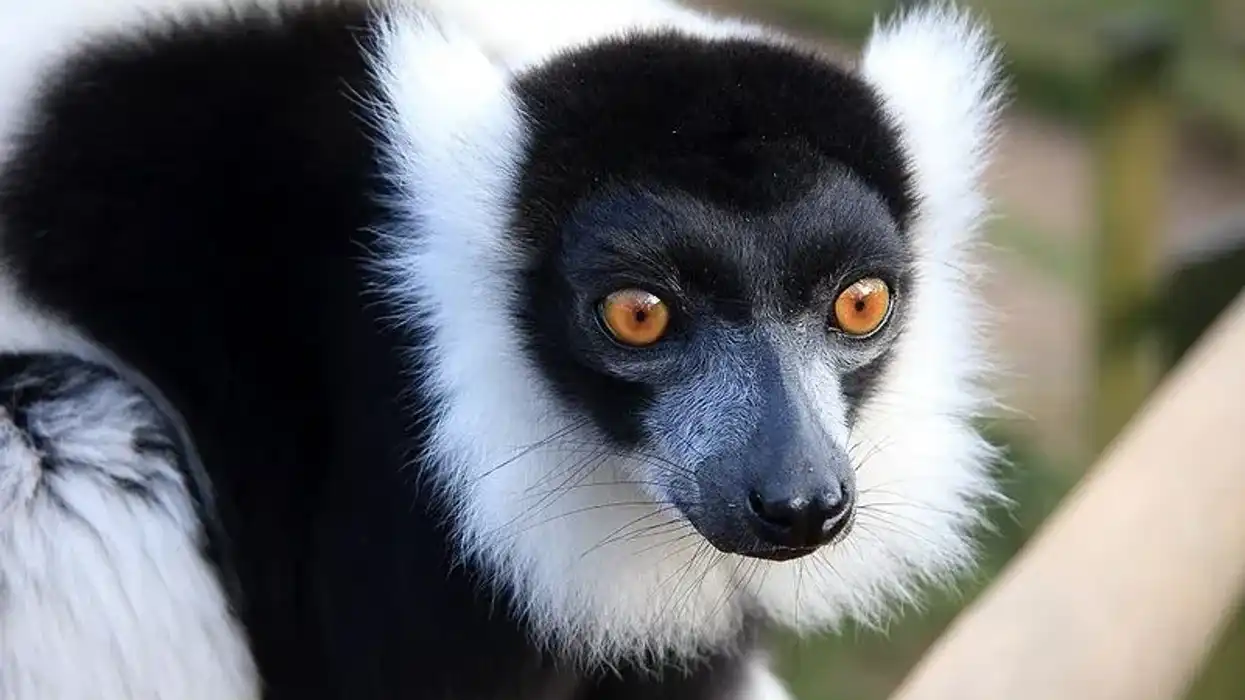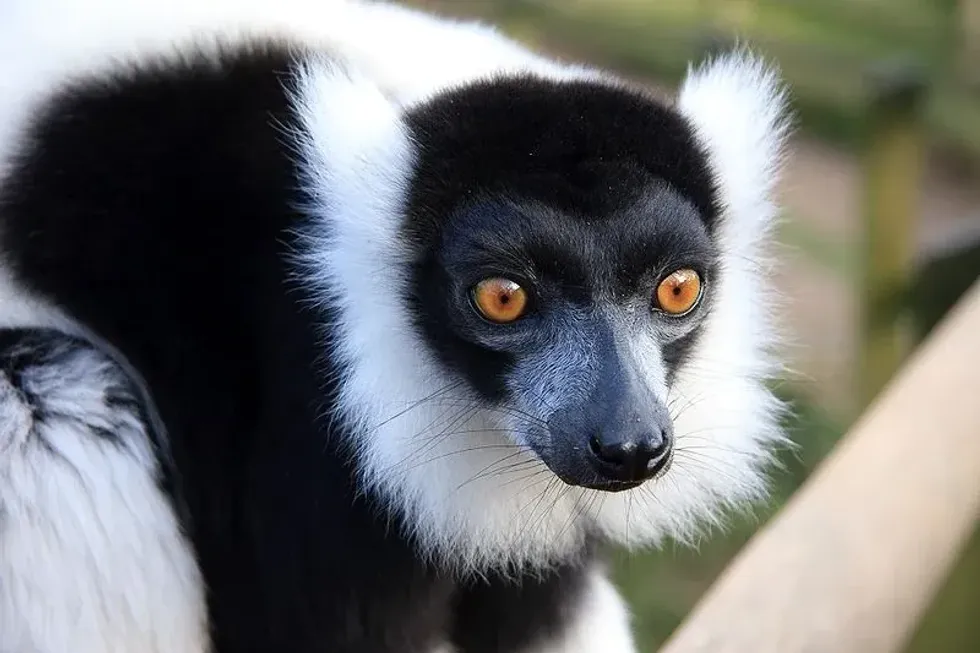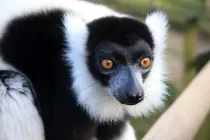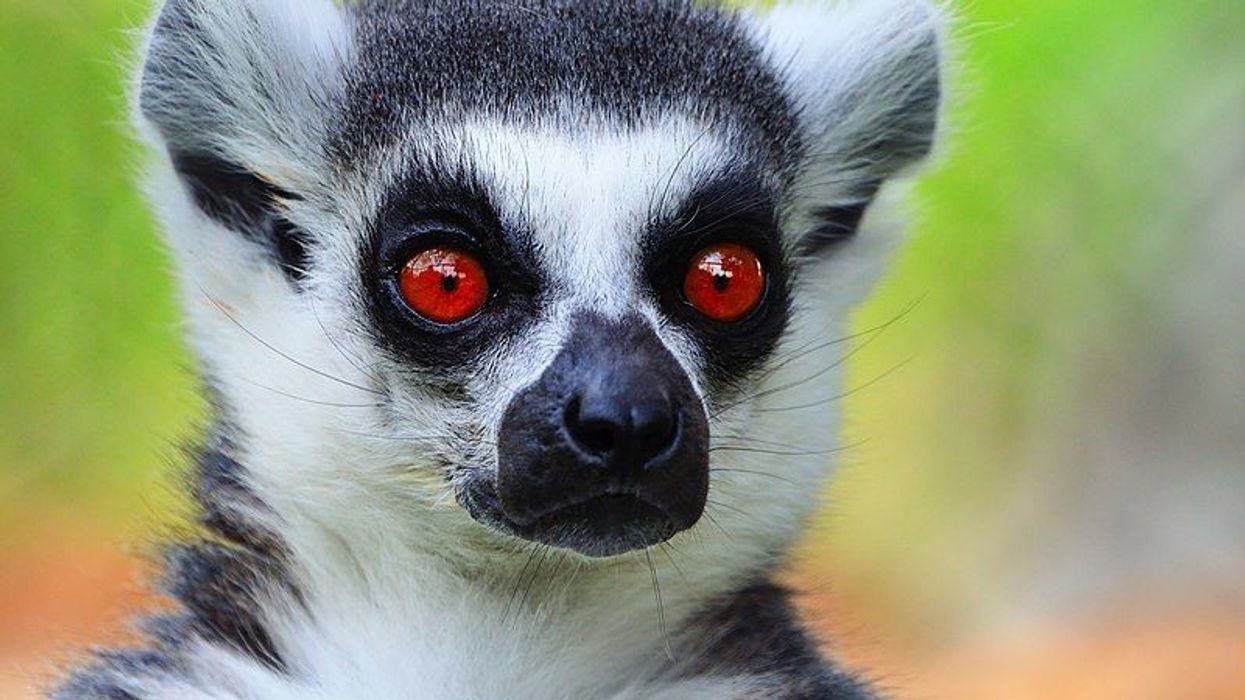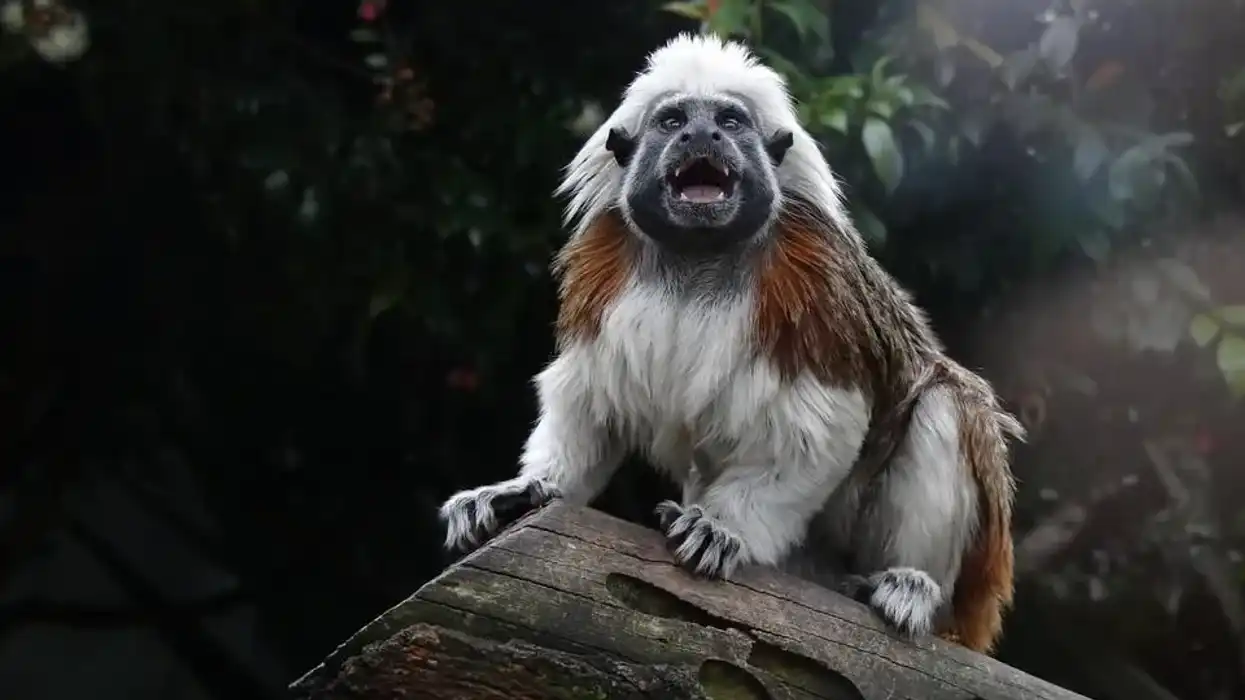Fun Black And White Ruffed Lemur Facts For Kids

Black and white ruffed lemurs (Varecia variegata; Syn- Varecia variegata variegata), belong to the order of primates and subphylum Vertebrata. These lemurs are endemic to Madagascar, off the African continent and are placed on the Critically Endangered list of animals because of a massive population loss over the years.
These lemurs have a social system that is unique in nature as they are the only species of primates known to build nests for their offspring. These lemurs are also known as one of the loudest primates in existence!
Black and white ruffed lemurs only have a positive impact on their surroundings as they are great pollinators since they feed on flowers and nectars during fruit scarcity.
Hopefully, with the reintroduction of these species in the wild after carefully raising them in zoos and reserves, we can see them get back to their previous population and become part of the ecosystem once again!
If you liked these true facts about Varecia variegata, then you'll surely like these facts about aye ayes and European otters too!
Black And White Ruffed Lemur Interesting Facts
What type of animal is a black and white ruffed lemur?
Black and white ruffed lemurs (Varecia variegata variegata) are primates that are endemic to Madagascar on the African continent. These primates belong to the Lemuridae family and the subfamily Lemurinae and are a subspecies of Madagascar endemic lemurs.
What class of animal does a black and white ruffed lemur belong to?
Black and white ruffed lemurs belong to the Mammalia class of animals.
How many black and white ruffed lemurs are there in the world?
These species of lemurs are currently listed as Critically Endangered by the IUCN Red List because of their low population size. According to the Primate Info Net (PIN), the black and white ruffed lemur population is anywhere between 1,000 to 10,000 individuals.
Where does a black and white ruffed lemur live?
Black and white ruffed lemurs (Varecia variegata) are endemic to Madagascar and are found in the dense rainforests of the region.
What is a black and white ruffed lemur's habitat?
The black and white ruffed lemur is usually found primarily in the eastern rainforests of Madagascar and is distributed throughout the Madagascar rainforests in small populations. Their geographic range includes south of the Mananara River in the southeastern part of Madagascar to the Antainambalana River which is located at the northwest part of the Bay of Antongil.
These primates occur in low-to-mid altitude rainforests and spend most of their time in tall trees.
Who does a black and white ruffed lemur live with?
The black and white ruffed lemurs have social systems that indicate their lifestyle is that of a group mentality. These lemur species are social in nature and live in groups that can be as large as 16 individuals, however, these large groups usually comprise smaller groups that form the larger ones.
Studies have shown that both in captivity and in the wild, these lemurs have unique lemur social systems. Meaning, during times when resources are low, they will break down into smaller groups and when the resources are abundant, these broken groups will rejoin to create the previously large group.
How long does a black and white ruffed lemur live?
Black and white ruffed lemurs (Varecia variegata) are known to have an average lifespan of 19 years in their natural wildlife habitat. In captivity, they can survive as long as 37 years! The oldest known black and white ruffed lemur was known to live for over 33 years which is a record for the members of this primate species.
How do they reproduce?
Both the male and female of the black and white ruffed lemur (Varecia variegata) species reach sexual maturity when they are between two and three years of age. Females are polyandrous, meaning they mate with multiple mates.
When these lemur species reach breeding season, the testicles of the males will grow in size and they will show acts of aggression towards one another. In the females, the genitals can be seen opening during the estrus which is a sign of being receptive to mating.
Male lemurs will approach the females and make a whining noise and then sniff her to see if she is welcoming or not, if she does not get aggressive, the male will mount her and they will copulate.
After successful copulation, the female will become pregnant and give birth to up to six offspring after a gestation period of 100-135 days.
What is their conservation status?
The black and white ruffed lemur (Varecia variegata) is currently listed as a Critically Endangered species. These primate species have been hunted for their meat and fur by the indigenous people of Madagascar and also have faced a loss of habitat because of the slash and burn method of deforestation by the natives.
Conservation efforts to protect these animals have been carried out in conservation sites and zoos. Two of the main conservation sites for the protection and housing of the black and white ruffed lemur species are the Betampona Reserve in Tamatave, and Nosy Mangabe, an island off the Madagascar eastern coast.
Black And White Ruffed Lemur Fun Facts
What does a black and white ruffed lemur look like?

The black and white ruffed lemurs are the largest quadrupedal lemurs that can be found in Madagascar. As their name suggests, they are black and white in color and have a thick coat of fur that helps them stay warm and dry in harsh weather conditions.
The hair on the abdomen, tail, inner limbs, forehead, top of the head, and extremities are black in color and the back, rump, hindlimbs, and flanks of these species are white.
The black and white ruffed lemur (Variegata variegata) can easily be differentiated from the subspecies of Hill's ruffed lemur (Varecia variegata editorum) due to the thick white band in the center of their back, which the Hill's ruffed lemur lack.
The ruffs around their chins are usually white with the rest of their body covered in black and they have long noses that bestow them with their good sense of smell.
How cute are they?
Black and white ruffed lemurs are one of the unique species of primates thanks to their amazing fur coat! These medium-sized primate species are a treat to look at and will enjoy the company of onlookers in zoos and parks!
How do they communicate?
Black and white ruffed lemurs use a variety of ways to communicate amongst themselves. Usually, most of the communication among these lemurs is done through vocal cues with loud calls and squeals.
These lemurs also use visual and olfactory cues as a mode of communication, especially in the case of foraging food. Their vision helps them in finding feeding grounds and the use of olfactory cues helps them in determining the ripeness of fruits.
These lemurs also mark their territory with scents by rubbing their anogenital parts on surfaces. These marks are used as a means to stop trespassing.
How big is a black and white ruffed lemur?
Black and white ruffed lemurs (Varecia variegata) are the largest lemurs in Madagascar and can reach a total body length of 43.3-47.2 in (110-120 cm) with their tails contributing to more than half of it. These long tails help them in balancing their body as they move from treetop to treetop.
How fast can a black and white ruffed lemur move?
The speed at which these lemurs can move is currently unknown hence no apt number can be stated. Some other interesting species to check out are the mongoose lemur and the red-ruffed lemur.
How much does a black and white ruffed lemur weigh?
Black and white ruffed lemurs (Varecia variegata variegata) are the largest primate found in Madagascar and have a body mass between 5.5-10.5 lb (2.5-4.8 kg) depending on the gender as the females are larger than the males.
What are the male and female names of the species?
There is no specific name for the male ruffed lemurs, but like other members of the lemur species, the female lemur is called a princess.
What would you call a baby black and white ruffed lemur?
Baby black and white ruffed lemurs are called pups.
Ruffed lemur pups model adult behavior from childhood and when they are two or three months old, lemurs will learn to travel closely behind the adults as they are too large to be carried by their mothers. Juvenile lemurs become independent as they reach adolescence and will become part of their mother's social groups.
What do they eat?
Black and white ruffed lemurs are herbivores and only eat plants and fruits. In seasons of fruit scarcity, these lemurs will resort to consuming flowers, nectars, and young leaves.
Are they poisonous?
No, black and white ruffed lemurs are not poisonous and in fact, they are consumed by the natives of Madagascar as bushmeat. Black and white ruffed lemur (Varecia variegata) overhunting by humans has played a large part in these species becoming critically endangered.
Would they make a good pet?
No, it is illegal to keep these species of lemurs as pets! According to the conservation efforts and order of the Madagascar government, keeping ruffed lemurs as pets is a punishable offense. Even with these laws in effect, many hotels and restaurants displace ruffed lemurs from their natural habitat and use them as household pets.
Did you know...
The black and white ruffed lemurs species are considered to be the largest pollinator in the animal kingdom.
Black and white ruffed lemurs are the only primates that give birth to a litter.
Black and white ruffed lemurs only come second to the howler monkeys in loudness!
These animals are the largest primate that can be found in Madagascar!
Black and white ruffed lemurs are one of the three recognized subspecies of Varecia Variegata, the others being the white-belted black-and-white ruffed lemur (V. v. subcincta) and the Hill's ruffed lemur (V. v. editorum).
Why are ruffed lemurs endangered?
Black and white ruffed lemurs are endangered mainly because of habitat loss due to human activities like mining, agriculture, logging, and other developmental aspects of the Madagascar region. The rainforests they inhabit are a great resource for humans as cleaning them not only gives them more land to work with, but also helps them in the logging industry.
Black and white ruffed lemurs' overhunting is one of the reasons alongside habitat loss that has caused a decline in population as they are hunted on a large scale for their meat and fur. Since these lemurs are diurnal, they are most active when the sun is up, making them an easy target for poachers and hunters.
These factors have played a huge role in the endangerment of these species.
Are they loud?
Black and white ruffed lemurs (Varecia variegata) are loud animals and display two types of communication methods. The first method is a loud inconsistent series of roaring that is followed up with irregular squeals that are high pitched in nature.
This method is used to alert others of the presence of a predator nearby. This call-out is also used when a male has been rejected by a female!
The second method of calls includes a series of short sounds in the form of a chuckle. This chuckle serves as a sign of territorial spacing with other groups.
Here at Kidadl, we have carefully created lots of interesting family-friendly animal facts for everyone to discover! Learn more about some other mammals from our two-toes sloth facts and ring-tailed lemur facts pages.
You can even occupy yourself at home by coloring in one of our free printable red ruffed lemur coloring pages.
We Want Your Photos!
More for You
See All
Bachelor of Arts specializing in Journalism and Mass Communication, Postgraduate Diploma in Sports Management

Moumita DuttaBachelor of Arts specializing in Journalism and Mass Communication, Postgraduate Diploma in Sports Management
A content writer and editor with a passion for sports, Moumita has honed her skills in producing compelling match reports and stories about sporting heroes. She holds a degree in Journalism and Mass Communication from the Indian Institute of Social Welfare and Business Management, Calcutta University, alongside a postgraduate diploma in Sports Management.
Bachelor of Arts specializing in Economics

Gowri RaoBachelor of Arts specializing in Economics
With a bachelor's degree in Economics from Krea University, Gowri is a highly skilled data analyst and an expert in regression and causation modeling. Her interests in economic trends, finance, and investment research complement her professional expertise. In addition to her professional pursuits, Gowri enjoys swimming, running, and playing the drums, and she is also a talented tutor.
Disclaimer
1) Kidadl is independent and to make our service free to you the reader we are supported by advertising. We hope you love our recommendations for products and services! What we suggest is selected independently by the Kidadl team. If you purchase using the Buy Now button we may earn a small commission. This does not influence our choices. Prices are correct and items are available at the time the article was published but we cannot guarantee that on the time of reading. Please note that Kidadl is a participant in the Amazon Services LLC Associates Program, an affiliate advertising program designed to provide a means for sites to earn advertising fees by advertising and linking to Amazon. We also link to other websites, but are not responsible for their content.
2) At Kidadl, we strive to recommend the very best activities and events. We will always aim to give you accurate information at the date of publication - however, information does change, so it’s important you do your own research, double-check and make the decision that is right for your family. We recognise that not all activities and ideas are appropriate for all children and families or in all circumstances. Our recommended activities are based on age but these are a guide. We recommend that these ideas are used as inspiration, that ideas are undertaken with appropriate adult supervision, and that each adult uses their own discretion and knowledge of their children to consider the safety and suitability. Kidadl cannot accept liability for the execution of these ideas, and parental supervision is advised at all times, as safety is paramount. Anyone using the information provided by Kidadl does so at their own risk and we can not accept liability if things go wrong.
3) Because we are an educational resource, we have quotes and facts about a range of historical and modern figures. We do not endorse the actions of or rhetoric of all the people included in these collections, but we think they are important for growing minds to learn about under the guidance of parents or guardians.
